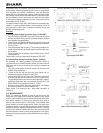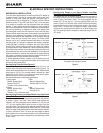
- 2 -
Ver. 6.0U _ Sep 6, 2012
Installation Manual for PV Modules
< HANDLING SAFETY >
1. Do not expose the PV module to excessive loads on the surface of the
PV module or twist the frame. The glass may break.
2. Do not stand or step on the PV module. The glass may be slippery,
and there is a risk of injury or electric shock if glass is broken.
3. Do not hit or put excessive load on the glass or back sheet. PV cells
may break.
4. To avoid damage to the back sheet, do not scratch or hit the back sheet.
5. To avoid damage to the terminal box and electricity leakage or shock,
do not hit the terminal box; do not pull the interconnect cables; do not
scratch the interconnect cable.
6. Avoid the connector from scratching or impacting the back sheet of the
module.
7. Install connector such that it is not exposed to direct sunlight.
8. Do not twist the interconnect cable excessively.
9. Never touch the end of the interconnect cables with bare hands when
the module is illuminated. Cover the surface of module with cloth or other
sufficiently opaque material to block the module from incident light and
handle the wires with insulated gloved hands to avoid electric shock.
10. Do not drill holes in the frame. It may compromise the frame strength
and cause corrosion of the frame.
11. Do not scratch the anodized coating of the frame (except for grounding
connection). It may cause corrosion of the frame or compromise the
frame strength.
12. Do not loosen or remove the screws from the PV module. It may
compromise the strength of the PV module and cause corrosion.
13. Do not touch the PV module with bare hands. The frame of the PV
module has sharp edges and may cause injury. Wear suitable gloves,
such as leather gloves with padding in the palm and finger areas.
14. Do not drop the PV module or allow objects to fall on the PV module.
15. Do not lift the PV module by only one side. The frame may bend.
Always use two hands to lift and carry the PV module on the long side
of the frame.
16. Some PV modules incorporate one or more support bars on the back
of the module. Do not mount or carry the PV module using the support
bar(s) on the back of the module.
< INSTALLATION SAFETY >
1. Always wear protective head gear, insulating gloves and safety shoes
(with rubber soles).
2. Keep the PV module packed in the carton until installation.
3. Do not touch the PV module unnecessarily during installation. The
glass surface and the frame may be hot. There is a risk of burns and
electric shock.
4. Do not work in rain, snow or windy conditions.
5. Due to the risk of electrical shock, do not perform any work if the
terminals of the PV module are wet.
6. Use insulated tools and do not use wet tools.
7. When installing PV modules, do not drop any objects (e.g., PV
modules or tools).
8. Make sure flammable gasses are not generated or present near the
installation site.
9. Insert interconnect connectors fully and correctly. Check all connections.
10. The interconnect cable should be securely fastened to the module
frame, the mounting racking or in a raceway to prevent movement
of the interconnect cable over time. Cable support should be done in
a way to avoid the connector from scratching or impacting the back
sheet of the module.
11. Do not touch the terminal box and the end of the interconnect cables
(connectors) with bare hands during installation or under sunlight,
regardless of whether the PV module is connected to or disconnected
from the system.
12. Do not unplug a connector if the system circuit is connected to an
operating load.
13. Do not work alone (always work as a team of 2 or more people).
14. Wear a safety harness when working above the ground.
15. Do not wear metallic jewelry which may conduct electricity and enable
electric shock during installation.
16. Do not damage the back sheet of PV modules when fastening the PV
modules to a support by bolts.
17. Do not damage the surrounding PV modules or mounting structure
when replacing a PV module.
18. Use UV resistant cable ties or other wire management hardware to
secure the interconnect cables. Drooping cables may cause various
problems, such as leading to electrical shorts.
19. Take proper measures for preventing the laminate (consisting of
encapsulant, cells, glass, back sheet, etc.) from dropping out of the
frame in case the glass is broken.
20. Cables shall be located so that they will not be exposed to direct
sunlight in order to prevent degradation of the interconnect cables.
21. In case of extreme snow build-up, the weight of the snow may causes
the module’s frame to deform. Take appropriate measures to minimize
any possible resulting damage.
22. It is recommended to install the PV module with the junction box at the
highest point.
A-3. PV MODULE COMPONENTS
A-4. TILT ANGLE SELECTION
The tilt angle of the PV module is measured between the surface of the
PV module and a horizontal ground surface. The PV module generates
maximum output power when it faces the sun directly. Five (5) degrees or
more is recommended for the tilt angle (see A-6 Maintenance).
For standalone systems with batteries where the PV modules are
attached to a permanent structure, the tilt angle of the PV modules should
be selected to optimize the performance based on seasonal load and
sunlight. In general, if the PV output is adequate when irradiance is low
(e.g., winter), then the angle chosen should be adequate during the rest
of the year. For grid-connected installations where the PV modules are
attached to a permanent structure, PV modules should be tilted so that the
energy production from the PV modules will be maximized on an annual
basis.
A-5. ELECTRICAL INSTALLATION
To ensure proper system operation and maintain the warranty, be
careful to observe the correct cable connection polarity (Figure 1) when
connecting the modules to a battery or to other modules. If not connected
correctly, the bypass diode(s) could be destroyed. All PV modules must
be grounded by electrical connection of the module frames to ground.
Care must be taken to arrange the system ground so that the removal of
one module from the circuit will not interrupt the grounding of any of the
other modules.
Cable characteristics
Cable category : PV Wire as described by UL Subject 4703
Cable size : 4mm
2










